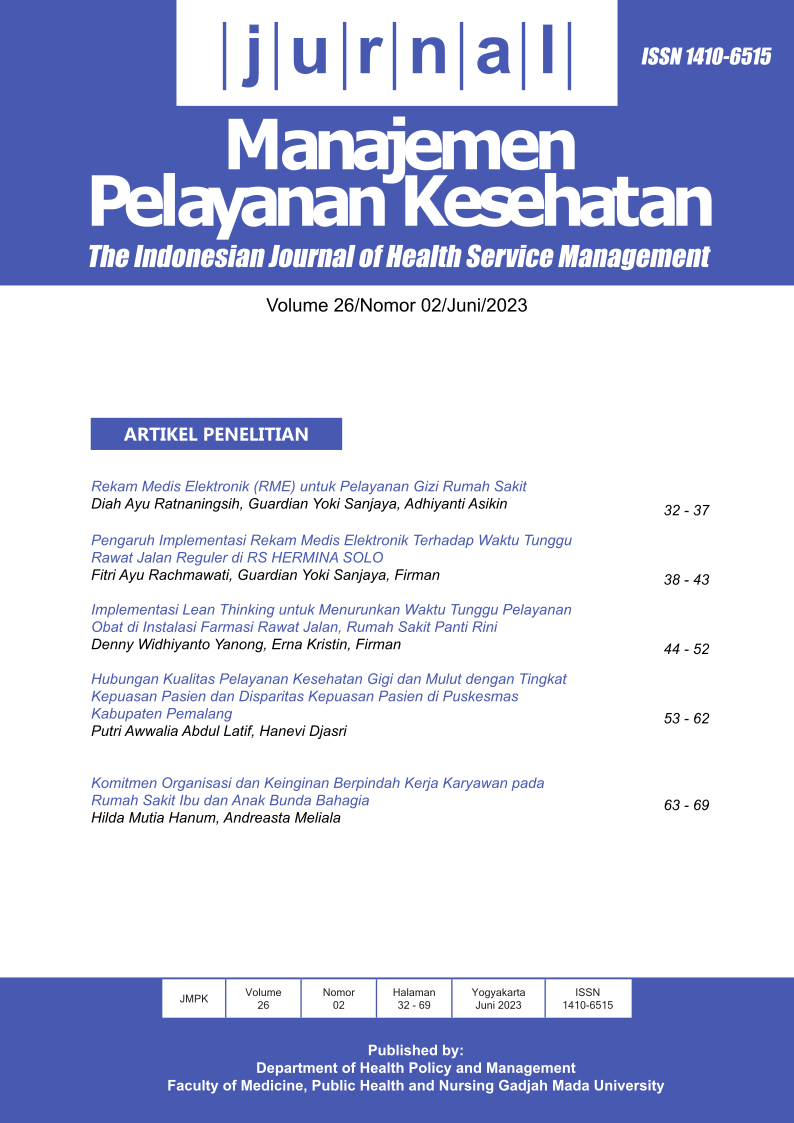KOMITMEN ORGANISASI DAN KEINGINAN BERPINDAH KERJA KARYAWAN PADA RUMAH SAKIT IBU DAN ANAK BUNDA BAHAGIA
Abstract
Background: A frequent phenomenon in human resources (HR) is that many employees leave their jobs (turnover). Efforts to control and reduce employee turnover begin with eliminating the desire to change jobs (turnover intention). There are many causes of turnover intention, including job satisfaction, work environment, and organizational commitment. High organizational commitment is what every organization, especially hospitals, expects from their employees. RSIA Bunda Bahagia shows an increasing turnover rate until 2022 reaching 79.4%. That condition proves that the turnover rate is high because the ideal condition of the turnover standard is 5-10% per year, so it is necessary to improve better employee management to achieve hospital
success.
Objective: This study aims to describe organizational commitment and turnover intention and measure the relationship of employee organizational commitment to turnover intention at RSIA Bunda Bahagia.
Methods: This type of research is an exploratory case study research with a single case research design with qualitative data presentation. This research was conducted for 2 to 3 months after Ethical Clearance was issued, which was conducted on 51 employees with the Three-Component Model (TCM) Employee Commitment Survey research instrument to measure organizational commitment and Turnover Intention Scale-6 (TIS-6) to measure turnover intention.
Results: Twenty-eight (54.9%) employees had a high level of organizational commitment, and 32 (62.7%) employees had a low turnover intention. Spearman’s Rank Correlation test results on organizational commitment and turnover intention showed a p-value of 0.001 (<0.05) with a correlation coefficient of -0.442. Organizational factors, individual factors, and social factors in organizational commitment have a relationship to turnover intention.
Conclusion: There is a significant unidirectional relationship between organizational commitment and turnover intention in employees of RSIA Bunda Bahagia, so management needs to increase organizational commitment in employees so that turnover intention rates decrease.
References
Mulyadi dan Setiawan., J. Sistem Perencanaan dan Pengendalian Manajemen, Sistem Pelipat Ganda, Kinerja Perusahaan, Jakarta: Rineka Cipta 2005
Aamir. M., Khan, S., dan Du, J. An Empirical Study of Turnover Intentions in Call Centre Industry of Pakistan. Journal of Human Resource and Sustainability Studies 2014, 2, pp. 206–214.
Nayak L. Job Satisfaction And Organizational Commitment As Factors Of Turnover Intention Of Irs Procurement Employees. Disertasi Doctoral Walden University 2002.
Allen and Meyer. Commitment In The Workplace (Theory, Research and Application). Sage Publication London 1997.
Bothma, C. F. C., dan Roodt, G. The Validation Of The Turnover Intention Scale. SA Journal Of Human Resource Management 2013, 11(1), pp. 1–12.
Utarini, A. Tak Kenal Maka Tak Sayang: Penelitian Kualitatif dalam Pelayanan Kesehatan, Yogyakarta: Gadjah Mada University Press 2020
Hussain, T., dan Asif, S. Is Employees’ Turnover Intention Driven by Organizational Commitment and Perceived Organizational Support?. Journal of Quality and Technology Management 2012, 8 (2), pp.1-10
Arkoubi, K. A., Cox, J. B., dan Estrada, S. D. National Human Resource Development in Transitioning Societies in the Developing World. Morocco: Advances in Developing Human Resources Journal 2006, 8(1), pp. 84-98
Copyright (c) 2023 Hilda Mutia Hanum, Andreasta Meliala

This work is licensed under a Creative Commons Attribution-NonCommercial-ShareAlike 4.0 International License.




